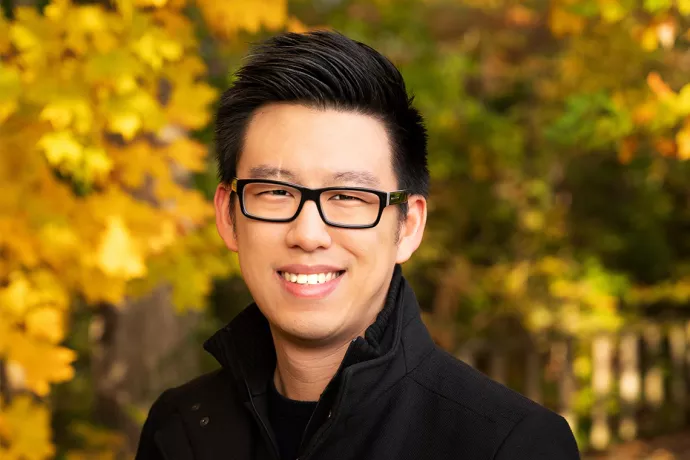At The Intersection of Innovation and Patient Care: A Q&A With Angus Ho (MMI ’17)

Since graduating from the Master of Management of Innovation program at UTM, Angus Ho (MMI, ‘17) has quickly distinguished himself as a leading Innovation Consultant in the healthcare field. Drawing on experience from his Master of Science in Molecular Biology, Angus met with us to talk about what it has been like to step out of the lab and into the innovative world of patient care.
You have an interesting job title - Innovation Consultant. Do people often ask you what that means?
It is definitely a great conversation starter! Whenever I am asked about my title, I often joke that my role as an “Innovation Consultant” is to do a little bit of everything. But honestly, to its core, it really comes down to networking with people, sharing ideas, and more importantly, turning ideas into reality.
You’re working with the innovation division of Mackenzie Health. Can you tell me about your role there?
Mackenzie Innovation Institute or Mi² is the innovation arm of the much larger healthcare provider, Mackenzie Health. I operate in an agile team with the aim to support and push the organization’s health innovation agenda.
I am plugged into different clinical project teams to provide a unique perspective on how we may use technology, design thinking methods and workflow designs to better address problem statements or even transform how certain operations are conducted to better enhance staff and patient experience. This is great because at times, I get to play the role of a “wild card” in the room to suggest and recommend exciting solutions to solve a problem. Some may say that I bring uncertainty to a project, but this is innovation, and it requires a forward-thinking mindset when you want to do things that have not been done.
A major part of my role is to stay connected with healthcare innovation and trends. A big part of my role is to meet with companies and discuss their products and solutions or to discuss strategic partnership opportunities to co-develop and grow their solutions in the Canadian market. This is where the fun begins. If we see a fit, then it’s time to engage with internal stakeholders and go through negotiations, project ideations, and marketing strategies with companies to ultimately develop solutions that are applicable to the organization and, by extension, scalable to the larger healthcare system.
So, while it is true that I really do a little bit of everything and talk to people, it involves a lot of operational and planning effort in my role to work closely with companies and finally bring an idea to life.
You completed your Masters of Science in Molecular Biology with a focus on cancer research. How was the transition from working and researching in the lab to your current role?
It was definitely a big change, in terms of career direction, knowledge landscape, social atmosphere and work methods.
Surprisingly though, there are interesting overlaps in both roles despite the very different work environments. In research, there was a lot of self-directed learning to ensure that I was up to date with the field. In my current role, behind all the exciting and innovative implementation and development of health tech solutions, I am constantly researching, learning, and thinking about how technology solutions can better the care delivery experience for patients, and by extension, the staff.
As a scientist, I was trained to be critical, but open minded to new ideas and concepts. In healthcare innovation, I am constantly challenged with the pursuit of finding the right opportunities for change and improvement at different levels to improve health outcomes without being carried away by implementation solutions for the sake of “cool” technologies. In our organization, we call this Applied Innovation. While the subject matter is very different, the skillset in critical research and thinking remains essential.
What is the coolest part of your job?
In my current role, I work very closely with different leadership and management levels of other companies, so the need to build business relationships is a very exciting aspect of my job. The opportunity to network with people from different industries is now something I look forward to. In fact, some of the coolest and most impactful ideas are often generated as a result of these “random collisions”.
To this end, the best part of my job is the opportunity to work in an environment with a multitude of talents and professions, physicians, clinicians, government, scientists, tech innovators and entrepreneurs. It is rewarding because I know we are all working together towards the common goal of creating the best possible patient care journey.
Do you have any advice for MMI students who will be going out into the world after graduation as innovators and change-makers?
Be ready to make mistakes, ask many questions, and learn from others. I have the fantastic opportunity to meet and work with a lot of innovators and entrepreneurs.
What I have come to realize is that many of the successful innovators are the ones who are not afraid to make mistakes but, more importantly, they are very open to criticisms and have the willingness to fix any issues and develop solutions together.
I wouldn’t dare to say that I know everything about health innovations, because I don’t. Healthcare is an ever-evolving landscape and there are new technologies and solutions being developed every day. The advice that I often share is that we should always be ready to learn from others and ask questions. As innovators and change-makers, we also need to equip ourselves with the most up-to-date information about the ecosystem. If you don’t have a clear understanding of what is happening around you, you cannot bring or inspire change in others.



